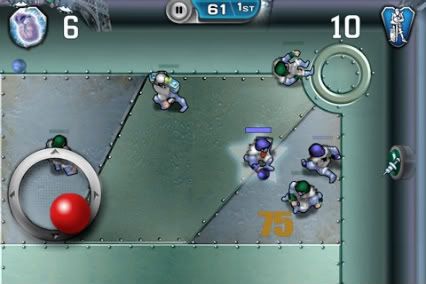
- Format: iphone/ipad (version reviewed), PSN
- Unleashed: iphone/ipad Out Now; PSN TBC
- Publisher: Tower Studios
- Developer: Vivid Games
- Players: 1 and multiplayer (local play only)
- Site: http://www.tower-studios.co.uk/
There is a retro scene out there, but in general game design and player expectations have changed, largely for the better. Most classic games just aren’t as good these days. Hence, when they are brought back to life on current platforms game designers have to find ways of reinventing the gameplay; often almost starting again, sometimes just by altering graphics to meet the demands of today’s gamers.
The issue, and we shall go straight to it, is that Speedball 2 was and still is pretty much perfect. Indeed we tested this theory, not by finding an Amiga, but by playing the other portable version. “What other version?” we hear you cry. Well, most of the gaming community seems to have forgotten this port, but there was a version on the GBA, and we have it. Not only that but it was more or less a perfect conversion of the loved game. It is with this reference that we shall tackle what, for us, is one of the biggest Ios releases for some time (enough Angry Birds already).
For those unfamiliar with Speedball, it’s basically a rugby/hockey hybrid with an ultraviolent, futuristic twist (the main influence was the original Rollerball movie). There’s a ball, there are goals for the ball to be flung into, there are various powerups – and there is lots and lots of violence. Fights between players are positively encouraged, and no Speedball match is complete without them.

Speedball 2: Evolution is based on the original Speedball 2, but somehow ends up being neither better nor worse – simply a type of parallel experience. The graphics have been changed, not improved. We feel they are worse in a way as the monochrome, metallic feel of the original has been lost a little – perhaps the idea was the make the game more cartoonish and accessible. The game has two control methods, one is tilt and the other is a virtual joypad. Our natural instinct was to try the joypad as that would be most like all previous control schemes. We preferred this method as it was easier to make your character stop and stand still (a great tactic traditionally – especially in multiplayer). However the ongoing issue of the Ios hardware and virtual joypads came into play after a while and it was clear the precision offered by a d-pad or proper joystick /nub was lacking.
The other option is tilt, which for general control and newcomers to the game is probably better. However as with all tilt games, it’s often hard to work out where the zero point is. The game does calibrate whenever you press the pause button, but it’s not obvious where the dead zone is, unlike for example in a flight game (as you can see the plane rising or lowering against the background making it clear). As a consequence standing still is almost impossible. Indeed it seems like the game is designed around the tilt mechanic, as it’s much slower than the original Speedball 2, which for us is an issue – part of the charm of the original was the speed and madness. This lower speed though is probably required for the tilt and dodgy virtual joypad to work effectively with the game.
As a game in its own right, it’s a good purchase. It’s not too much money, offers the traditional mix of single player and local multiplayer modes, and for those who do not have the GBA version it will be the closest experience they will get to the original. Hopefully they will up the tempo for the PSP/PS3 Minis version, which will be able to take advantage of a d-pad and analogue stick/nub. Certainly, that version should be just as good as the original. If only they would re-release the GBA version…
















Comments